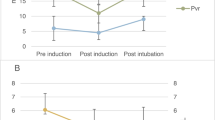Abstract
Changes of circulating blood volume (CB volume) measured by the dual indicator dilution method were observed in 33 chronically instrumented mongrel dogs following either alpha-chloralose-urethane (C group), additive isoflurane (I group) or sevoflurane anesthesia (S group). These anesthetic groups were each divided into two subgroups with regard to respiratory care, namely Cp, Ip and Sp for those with intermittent positive pressure ventilation (six animals per subgroups), and Cs, Is and Ss for those with spontaneous breathing (five animals per subgroups).
The CB volume under positive pressure ventilation remained unchanged in the Ip and Sp groups at both 0.5 and 1.0 MAC, and in the Cp group. The CB volume remained essentially unchanged in the Cs and Is groups at both 0.5 or 1.0 MAC, but the plasma volume tended to increase slightly in the Is group at 1.0 MAC.
In the Ss group under spontaneous breathing, however, the CB volume increased from 84.4±7.0 to 91.4±7.7 at 0.5 MAC, and to 91.4±10.2 ml·kg−1 at 1.0 MAC (0.01<P<0.05). These increases were caused by an increase in the plasma volume.
The above data suggests that a concomitant increase in the venous pressure associated with an increase in the intrathoracic pressure produced by positive pressure ventilation would attenuate changes in the CB volume during sevoflurane anesthesia.
Similar content being viewed by others
References
Gibson JG, Branch CD: Blood volume changes during surgical procedures. Surg, Gynec & Obst 65:741–747, 1937
Stewart JD, Rourke GM: Changes in blood and interstitial fluid resulting from surgical operation and ether anesthesia. J Clin Invest 17:413–416, 1938
Price HL, Helrich M, Conner EH: A relation between hemodynamic and plasma volume alterations during general anesthesia in man. J Clin Invest 35:125–131, 1956
Nakajo N, Matsumoto H, Takaori M: The effect of anesthetics (halothane and diethylether) on blood volume and flow of various organs in the dog. Masui 29:641–647, 1980
Grable E, Finck AJ, Abrams AL, et al: The effect of cyclopropane and halothane on the blood volume in man. Anesthesiology 23:828–831, 1962
Steffey EP, Howland D Jr: Isoflurane potency in the dog and cat. Am J Vet Res 38:1833–1836, 1977
Kazama T, Ikeda K: Comparison of MAC and the rate of rise of alveolar concentration of sevoflurane with halothane and isoflurane in the dog. Anesthesiology 68:435–437, 1988
Guyton AC, Jones CE, Coleman TG: Cardiac output and its regulation, Circulatory physiology 2nd. edition. Philadelphia, WB Saunders, 1973, pp. 11
Stevens WO, Cromwell TH, Halsey MJ, et al: The cardiovascular effects of a new inhalation anesthetic, Forane, in human volunteers at constant arterial carbon dioxide tension. Anesthesiology 35:8–16, 1971
Akazawa S, Shimizu R, Kasuda H, et al: Effects of sevoflurane on cardiovascular dynamics, coronary circulation and myocardial metabolism in dogs. J Anesth 2:227–241, 1988
Gibson JG, Seligman AM, Peacock WC, et al: The distribution of red cells and plasma in large and minute vessels of the normal dog, determined by radioactive isotopes of iron and iodine. J Clin Invest 25:848–857, 1946
Hausner E, Essex HE, Mann FC: Roentgenologic observations of the spleen of the dog under ether, sodium amytal, pentobarbital sodium and pentothal sodium anesthesia. Am J Physiol 121:387–391, 1938
Gregersen MI, Rawson RA: Blood volume Physiol Rev 30:307–342, 1959
Heath ML, Vickers MD, Dunlap D: A comparison of macrodex and stored blood as replacement for blood loss during planned surgery. II: Changes in peripheral haematocrit and whole body/large vessel haematocrit ratio. Br J Anaesth 41:816–820, 1969
Nakanishi Y: Changes of distribution of circulating red cells following administration of hydroxyethyl starch and crystalloid solution in hemorrhagic shock. Masui 21:771–780, 1972
Nakajo N, Takaori M: Changes in F cell ratio following hemorrhagic shock —Treatment with phenoxybenzamine— Clin Physiol 6:65–72, 1976 (Japanese)
Doi M, Ikeda K: Respiratory effects of sevoflurane. Anesth Analg 66:241–244, 1987
Author information
Authors and Affiliations
About this article
Cite this article
Hamada, H., Takaori, M., Kimura, K. et al. Changes in circulating blood volume following isoflurane or sevoflurane anesthesia. J Anesth 7, 316–324 (1993). https://doi.org/10.1007/s0054030070316
Received:
Accepted:
Issue Date:
DOI: https://doi.org/10.1007/s0054030070316




